Medals relating to Flight
This page shows medals that relate to flight. This includes the sub-categories of airplane manufacturers, competitions, races, allegory, Icarus, etc.
Please let me know if I missed a flight-related medal that is already on this site but not part of this collection.
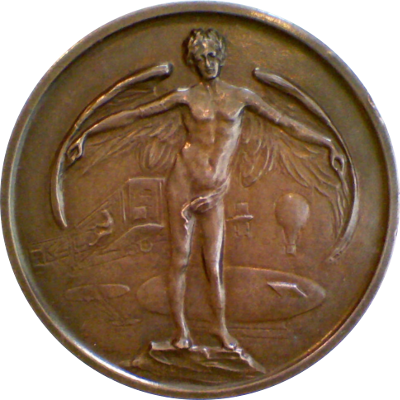
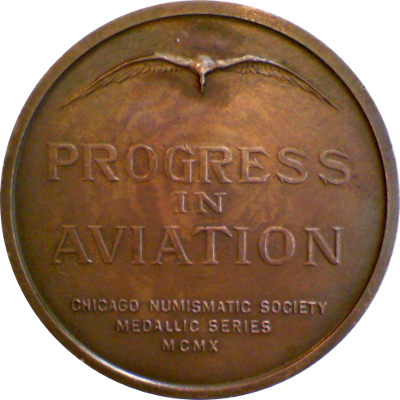
This medal's obverse bears a male figure with wings affixed to his outstretched arms, four different methods of manned flight in background: a hot air balloon, a dirigible, and two early-model airplanes.
The reverse bears bird in flight. Across center, PROGRESS / IN / AVIATION / CHICAGO NUMISMATIC SOCIETY / MEDALLIC SERIES / MCMX
The second art medal issued by the Chicago Numismatic Society (the precursor to the Chicago Coin Club) was dedicated to Aviation. In the early 20th century Chicago was one of the hotbeds of aviation engineering. Thus it came as no big surprise that it was decided to pick Progress in Aviation as the theme for an art medal. Carl Schrieber won the competition for the design of this medal.
The circular medal measures 51mm in diameter and was struck in bronze by Whitehead & Hoag of Newark, New Jersey. The reported mintage in bronze is 200 pieces. The silver pieces were struck later, possibly by the U.S. Mint. No mintage is reported.
References: Malpas 186
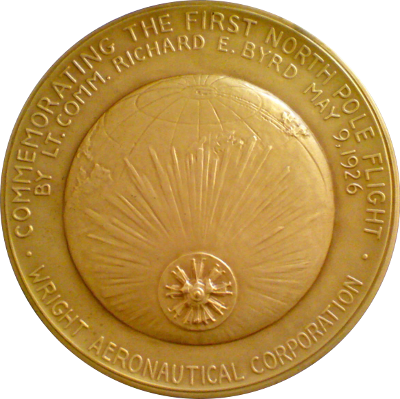

The obverse bears a globe in center with north pole visible. Cyclone engine with emanating rays superimposed. Along top edge in two lines, COMMEMORATING THE FIRST NORTH POLE FLIGHT / BY LT. COMM. RICHARD E. BYRD MAY 9, 1926; along bottom edge, WRIGHT AERONAUTICAL CORPORATION
The reverse shows Byrd's airplane in flight over exaggerated north pole of globe, dog sled with two men laboring beneath, clouds swirling from bottom and left. Signed KILENYI at left bottom.
Rear Admiral Byrd (1888-1957) was an American naval officer who specialized in feats of exploration. He was a pioneering American aviator, polar explorer, and organizer of polar logistics. Aircraft flights, in which he served as a navigator and expedition leader, crossed the Atlantic Ocean, a segment of the Arctic Ocean, and a segment of the Antarctic Plateau. He might well have become the first human to cross the Atlantic by plane in a non-stop flight but a crash during a practice takeoff delayed his flight and Charles Lindbergh managed the feat before he could try again.
Byrd's attempt to reach the North Pole by plane was undertaken on May 9th, 1926. His plane, named "Josephine Ford" after the daughter of expedition sponsor and Ford Motor company president Edsel Ford, was a German Fokker F-VII Tri-motor monoplane. Byrd and pilot Floyd Bennett took off from and landed at Spitsbergen after covering 1,360 miles in 15 and a half hours. Byrd claimed to have reached the North Pole though this is very much doubted today. Regardless of the ultimate veracity of his claim, he and Bennett were celebrated as heros upon their return and awarded the Medal of Honor.
The medal measures 100mm (3 15/16in) in diameter and was struck by the Whitehead-Hoag Company.
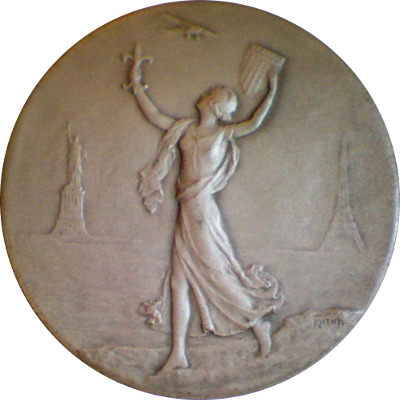

The obverse bears standing female figure, arms raised, holding fleur-de-lis in her right and U.S. shield in her left, facing left; to her left, Statue of Liberty; to her right the Eiffel Tower; above, Linbergh's plane. Signed at lower right, KILENYI
The reverse bears Lindberghs Spirit of St. Louis over cloud=shrouded globe with his historic flight route marked as a dotted line. Below, COMMEMORATING / THE FIRST NEW YORK-PARIS FLIGHT / BY CAPT. CHARLES A. LINDBERGH / "SPIRIT OF ST. LOUIS / NEW YORK MAY 20TH PARIS MAY 21ST 1927
The edge is marked STERLING.
Lindbergh's historic flight captured the world's interest like few other events and he was celebrated as a hero wherever he went. His return to St. Louis, the city for which he had named his plane, was a triumph. A large celebratory banquet was organized and bronze versions of this medal were handed to every attendee.
While the bronze pieces are relatively common, the silver and gold variants are exceedingly rare. The one gold piece was presented to Captain Charles Lindbergh at the dinner in his honor and the silver pieces probably to people involved with the flight and maybe dinner organizers.
The medal measures 83.2mm in diameter and was struck in bronze, silver, and gold by Whitehead-Hoag of Newark. The reported mintages are 1 piece in 14k gold, 25 in silver, and 2000 in bronze.
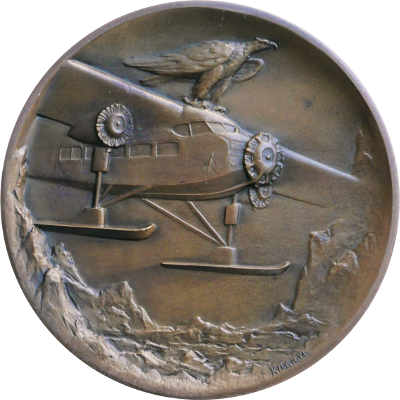
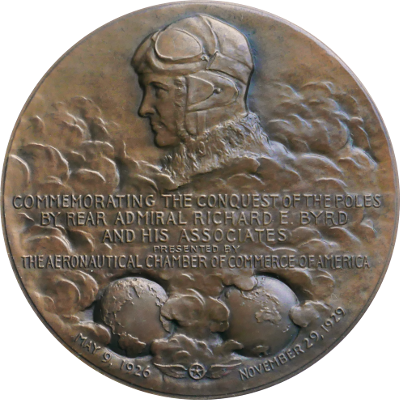
The obverse bears eagle perched on airborne Ford tri-motor; polar scene below, Signed at bottom right, KILENYI.
The reverse bears a bust (l.) of Richard Byrd wearing aviator's goggles emerging from a bank of clouds. Across, COMMEMORATING THE CONQUEST OF THE POLES / BY REAR ADMIRAL RICHARD E. BYRD / AND HIS ASSOCIATES / PRESENTED BY / THE AERONAUTICAL CHAMBER OF COMMERCE OF AMERICA; along bottom edge, MAY 9 1926 - NOVEMBER 29 1929.
The medal measures 82.6mm (3.25") in diameter and was manufactured by Whitehead & Hoag. During the presentation banquet one gold medal was given to Admiral Byrd, his associates received silver medals, and all other guests received bronze medals. The exact mintage is not reported.
References: Marqusee 217

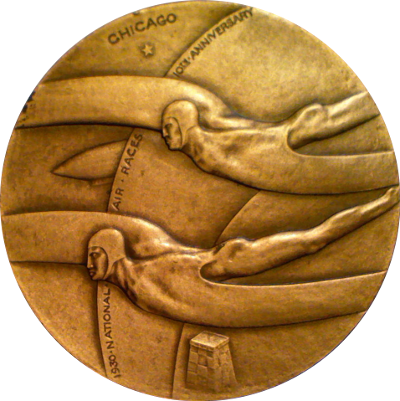
The medal's obverse bears art deco style bust of a pilot in a leather flying helmet with laurel leaf crown, up-turned wings behind pilot, star above. To left and right of pilot, around edge, THE OLYMPIAD - OF THE AIR; signed at lower left, OSKAR J W HANSEN Sc.
The medal's reverse bears relief of two art deco style winged pilot figures in flight above tower. Above, CHICAGO; Along background arc, 1930 NATIONAL - AIR RACES - 10TH ANNIVERSARY
Oskar Hansen (1892-1971) designed this art deco bronze medal to celebrate the 1930 National Air Races that took place in Chicago. It was the 10th anniversary of the races and the first year for The Thompson Trophy. Hansen is best known for his bronze works in connection with The Hoover Dam.
This medal measures 63mm (2.5in) in diameter and was struck by the Medallic Art Company of New York.
All that being said, this is a fairly rare medal that typically trades on eBay between $100 and $300.
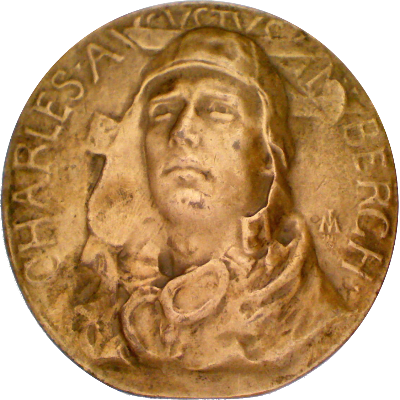
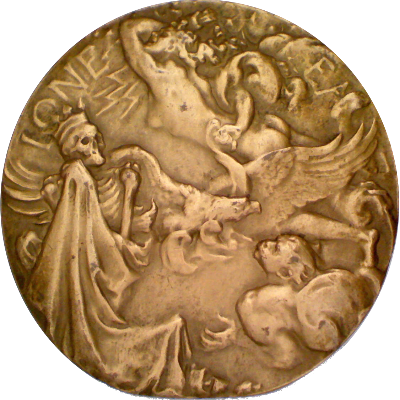
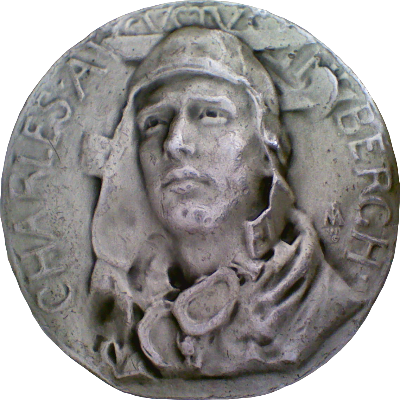
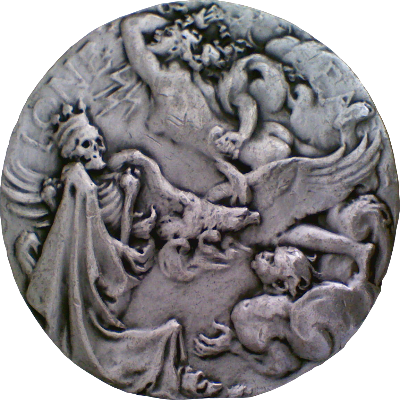
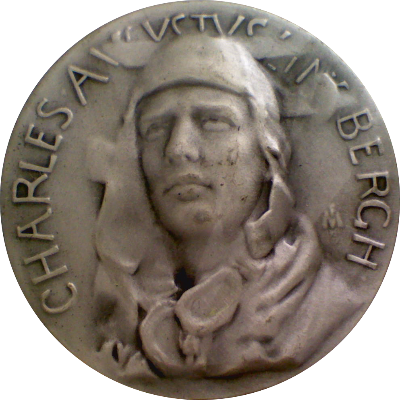
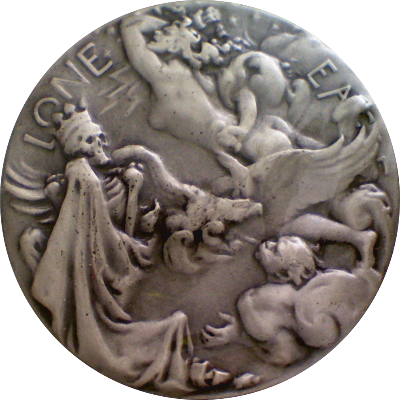
This medal was chosen as the fourth issue of the prestigious Society of Medalists series in 1931. The obverse bears a likeness of Charles Lindbergh wearing flight gear, goggles dangling over his chest, with the inscription "CHARLES AUGUSTUS LINDBERGH" and Frederick MacMonnies' monogram FM / 1931 / ©
The reverse bears an allegorical scene together with the inscription "LONE EAGLE."
Lindbergh's non-stop transatlantic flight from Long Island to Paris took place between May 20th and 21st 1927. Not only did he win $25,000 in prize money for the first non-stop flight from New York to Paris, he also captivated the imagination of an entire generation. Upon his arrival at the airfield of Le Bourget, just outside of Paris, a 100,000 strong crowd gave him a hero's welcome. His achievement was commemorated in countless stamps, medals, and commemorative issues of all kinds.
MacMonnies created this medal four years after the flight and late in his career. He tried to convey Lindbergh' spirit
and courage on the obverse.  In MacMonnies' own words:
In MacMonnies' own words:
"To attempt to commemorate Lindbergh's mighty achievement within the tiny compass of a three inch medal is preposterous, and if one does not succeed in represeting even a faint suggestion if the sublime courage that faced appaling odds - the fascinating problem is compensation enough. In the head of Lindbergh I have tried to catch something of the inner belief and nobility of vision of the boy, together with the experience of the master airman."
MacMonnies likely based his obverse design on the iconic photo of Lindbergh shown here.
Struck by the Medallic Art Company of New York, this medal measures 73mm in diameter. The reported production quantity is 1,989 in bronze and 250 in silver though there were two additional 32mm-diameter editions in bronze and silver.
References: Marqusee 249
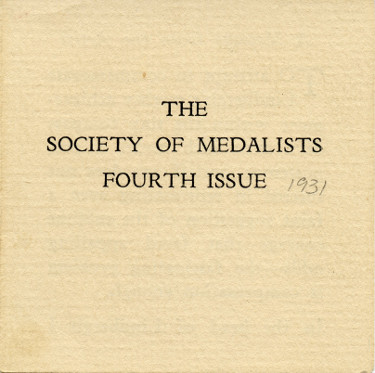
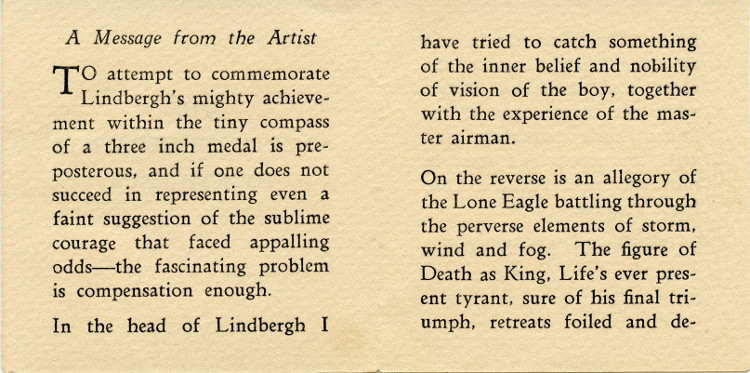
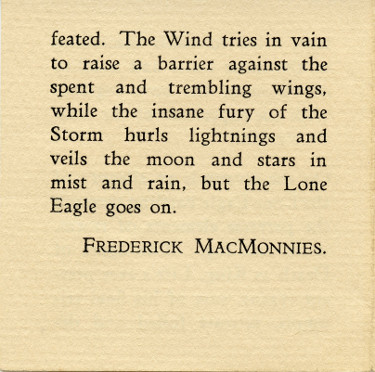
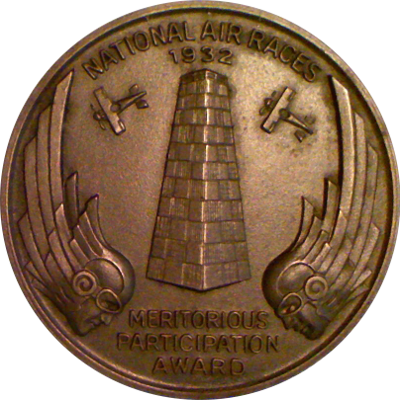
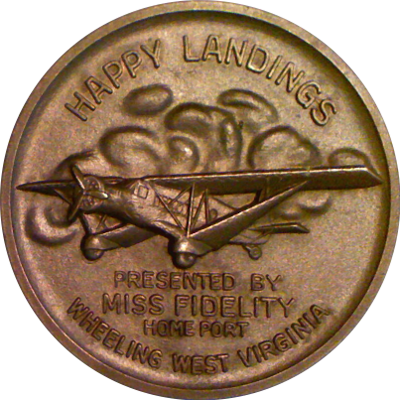
The obverse bears a central pylon flanked by two aircraft and two Art Deco-style winged heads. Above, NATIONAL AIR RACES / 1932; below, MERITORIOUS / PARTICIPATION / AWARD.
The reverse shows a Bellanca P200 plane in front of clouds. Above, HAPPY LANDINGS; below, PRESENTED BY / MISS FIDELITY / HOME PORT / WHEELINGS WEST VIRGINIA.
The Bellanca P200 airbus was built for $45,000 for the Fidelity Investment Company of Wheeling, West Virginia. It was one of nine built by the Bellanca Aircraft Corporation of New Castle, Delaware, and was one of the most advanced and economic commercial airplanes of its day. In 1934 federal regulations prohibited single engine transports on United States airlines, virtually eliminating the airbus' market. In Canada the P200 and its successor, the P300, were used into the 1970's to ferry ore, supplies and the occasional passenger from and to remote northern mining sites.
One of these small medals was awarded to every participant of the 1932 National Air Races held in Cleveland. The winged heads on this medal are reminiscent of Oskar Hansen's better known Olympiad of the Air medal from two years earlier.
The medal measures 36.7mm (1.5in) in diameter and was struck in bronze in an unknown mintage.
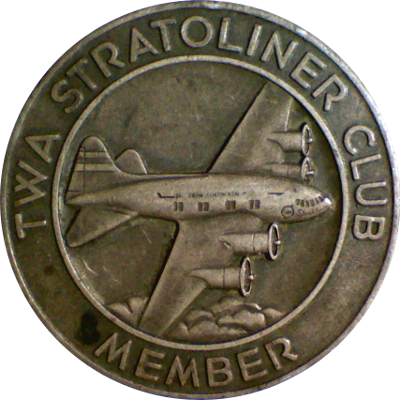

This medal's obverse bears image of four-engine stratoliner in flight above clouds. Around, TWA STRATOLINER CLUB - MEMBER
The medal's reverse bears same plane in flight from different perspective. Around, 4-ENGINE OVERWEATHER - STRATOLINER
The edge is marked STERLING BALFOUR
The Boeing 307 Stratoliner was the first commercial transport aircraft to enter service with a pressurized cabin. This feature allowed the aircraft to cruise at an altitude of 20,000 ft (6,000 m), well above many weather disturbances. While Howard Hughes had taken early delivery of a 307 in 1938 to attempt an around-the-world record flight the planes officially entered service in 1940 and were primarily used by the U.S. Air Force, Trans World Airlines (TWA), and Pan American Airways (PANAM). The last Stratoliner was retired in 1975.
The medal measures 32mm in diameter and was struck in bronze and sterling silver by the L.G. Balfour Company of Attleboro, Massachusetts.
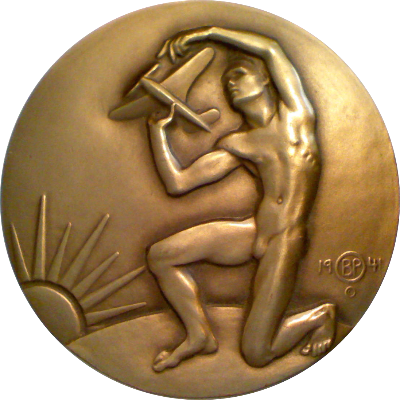
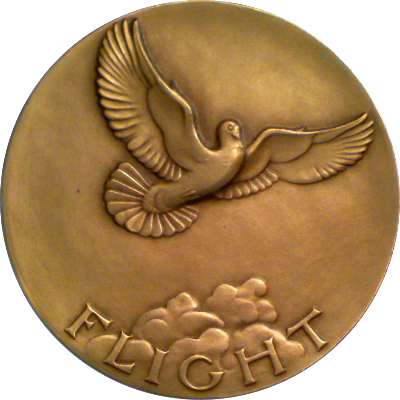
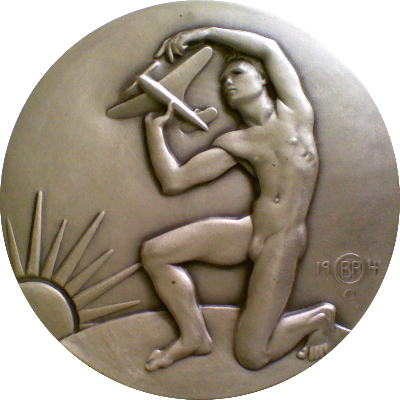
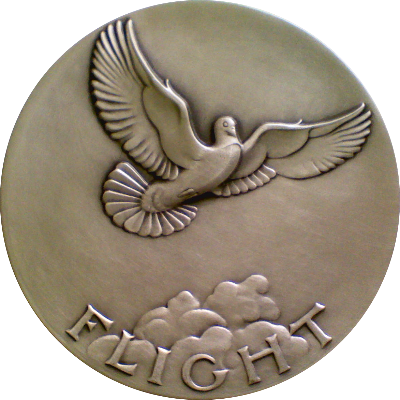
This medal was chosen as the 26th issue of the prestigious Society of Medalists series in 1942.
The obverse bears kneeling nude youth holding an airplane model in right hand, left hand on propeller; sun at left horizon. To right, date and signature 19 (circled BP) 41 / ©
The reverse bears dove in flight over fleecy clouds. Below, FLIGHT
Brenda Putnam wrote in the brochure accompanying the medal:
"Although this medal is issued during a preiod when the entire world is engaged in a gigantic struggle on land, at sea, and in the air, the theme of the medal is not warlike. The lad is no warrior, and the bird no eagle. Rather does the design concern itself with man's creative struggle to win supremacy in a vast new region, -the air. The war proves only too well the appalling destructive power of fighting and bombing planes. But beyond the war -and there will surely be a beyond- there are infinite possibilities for constructive and humanitarian activities in man's conquest of the air."
This medal measures 73mm in diameter and was produced by the Medallic Art Company of New York which struck 759 pieces in bronze and 100 in silver.
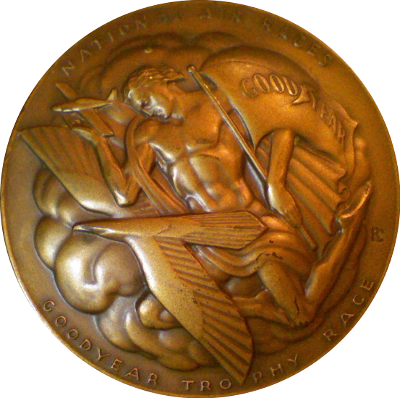
The medal bears a flying eagle and nude man, holding GOODYEAR banner in eft and small plane in right, over swirling clouds. Above, NATIONAL AIR RACES; below, GOODYEAR TROPHY RACE; to right, signed (monogram PRC).
Chambellan did a lot of work for Goodyear. In addition to this trophy medallion, he designed several medals for Goodyear dealers and business partners.
It is not known when Chambellan designed this medal but it was first awarded in 1947. The Goodyear Trophy Race was a newly introduced event at the Cleveland National Air Races in 1947. At the end of the first post-war Cleveland National Air Races, a lot of specators had walked out because the ex-military airplanes were too similar and as a consequence the races were not as exciting to watch as the pre-war competitions that had sported highly individual racing airplanes. The organizers resurrected an old idea for small, low-powered, custom-built "midget" airplanes that could race around a smaller track closer to the spectators. The Goodyear Trophy Race was born.
There is no information about the medal itself that I could locate and I would appreciate any help. My copy is mounted an a 268mm x 200mm (10.5in x 7 7/8in) wooden board with a name plate reading ROBERT S. HOPKINS / RACE PLANE BUILDER / 1947.
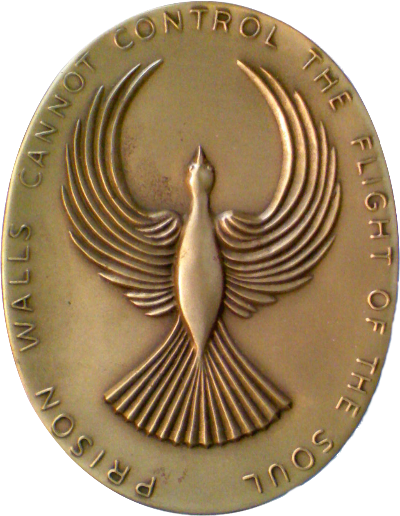
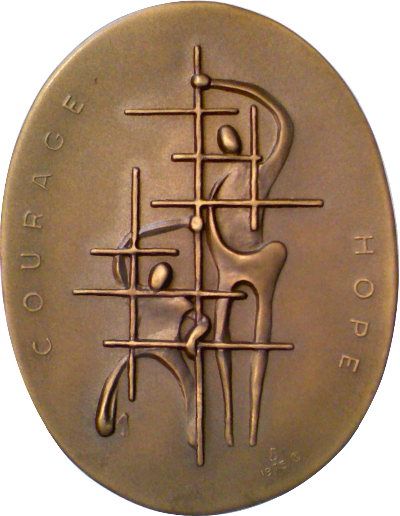
This medal was chosen as the 91st issue of the prestigious Society of Medalists series in 1975.
The obverse bears stylized prisoners behind bars. To left and right, COURAGE / HOPE; at lower right, (FS monogram) / 1975©
The reverse bears stylized bird in flight. Around, PRISON WALLS CANNOT CONTROL THE FLIGHT OF THE SOUL
The oval medal measures 65mm x 84mm and was produced by the Medallic Art Company. It is reported to have struck 1,350 pieces in bronze and 185 in silver.